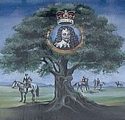If there is one thing most people know about the Escape, it is that Charles hid for a time in an oak tree. Unusually, for a well-known historical fact, it is actually true, or, to be more exact, there are several sources which confirm its truth and none which suggest otherwise. We definitely know that Charles himself was a great proponent of the story.
So what happened? There are other accounts on this site of the events leading up to the arboreal incident so I will restrict myself to the immediate circumstances. Charles arrived at Boscobel House on 6 September, in desperate trouble. His hopes to regain his father’s crown had turned to dust, he had seen three thousand of his men die in battle, his one contingency plan, to escape to France though Wales had proved to be hopeless. He was dog-tired, his feet were in tatters, Parliamentarian troops were everywhere; he was at the end of his tether. All his supporters could do was shove him up a pollarded oak tree in the nearby woods and hope for the best. The strangely named Captain Careless, one of his Officers, joined him there and supported him as he slept. Troops passed underneath in the woods but, it seems, didn’t look up. From all accounts the deep sleep he enjoyed played an important part in restoring his spirits.
At all events, he saw hiding in that tree as being the central event of his escape and in 1664, the King’s birthday of 29 May was designated Oak Apple Day by Act of Parliament and a special service was inserted in the Book of Common Prayer. For over 200 years the day was celebrated by the wearing of a sprig of oak leaves in remembrance of the events.

The wood near Boscobel House to which the tree originally belonged has long since disappeared but a tree still survives on the site. It is not the original Royal Oak which is recorded to have been destroyed during the seventeenth and eighteenth centuries by tourists who cut off branches and chunks as souvenirs. The present day tree is believed to be a two or three hundred year-old descendant of the original and is thus known as Son of Royal Oak. The field in which the tree stands, unlike Boscobel House itself, is not owned by English Heritage; it is owned and farmed by Francis Yates Partners, who allow the public access along a path from the garden of the house. In 2000, Son of Royal Oak was badly damaged during a violent storm and lost many branches. In September 2010, it was found to have developed large and dangerous cracks. Since 2011 the tree has been surrounded by an outer perimeter fence to ensure the safety of visitors.

Three third generation descendants of the Royal Oak have been ceremonially planted nearby:
- In 1897, a tree was planted on the western edge of the garden of Boscobel House by Augustus Legge, then bishop of Lichfield, to commemorate the Diamond Jubilee of Queen Victoria.
- A further tree was planted in 1951, to mark the tercentenary of Charles II’s escape, near the site of the original Royal Oak, by Orlando Bridgman, 5th Earl of Bradford, who was the owner of Boscobel House at the time, .
- Another oak sapling grown from one of the Son’s acorns was planted in 2001 by Prince Charles. Now in pole position to become the “New Royal Oak’ in due course.
Eight ships of the Royal Navy were called The Royal Oak, as were hundreds of inns and pubs. Its fame will outlive us all.


